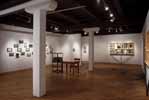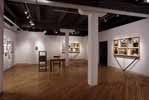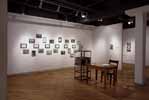thumbnails
(click on images to enlarge)
 1. installation view |
 2. installation view |
 3. installation view |
 4. installation view |
| |
|||
Alltagsgeschichten (some histories of everyday life) |
1992-96 • page 1 of 3 |
|---|
thumbnails (click on images to enlarge) |
|
|||||||||||
|
|
|
|||||||||||
Project description • Alltagsgeschichten This project evolved directly from the installation work, Places of Repose: Stories of Displacement (1989). It examines three specific former displaced persons camp sites in southern Germany that my family members resided in for varying lengths of time between 1945-1950. These were not necessarily traditional "camps" but were located at a former military base, Funk Kaserne, in Munich, a hotel in the spa town of Bad Wörishofen, and a set of apartment blocks in the Augsburg suburb of Hochfeld. The sites were explored from several perspectives. Historical materials were gathered from family sources, institutional archives such as those at the United Nations in New York (as the UN administered the displaced persons camps) and from my own visits and documentation of the sites as they appeared in 1992 more than 40 years after they were used as school and housing for some of the millions of refugees wandering the roads of Europe after 1945. Many, like my Latvian relatives, refused to return to a country occupied by Soviet Russia. In spite of intermittent attempts to introduce "repatriation" programmes, most former East Europeans would not go back. The installation work was organized into three components that are partially presented on the three pages of the Alltagsgeschichten section of this website: 1. three inverted house forms that contained the contemporary colour photographs and diary excerpts from my travels to the three camp sites; 2. a set of small metal-framed archival images
|
and excerpts from interviews with family members (printed onto the blank pages of passports that were issued to "stateless" persons after the war); and 3. a functional "archive" of my project that could be accessed by visitors to the gallery. The latter archive took the form of a custom-built transparent filing cabinet containing all of my research materials and a table and chair for gallery visitors to, in a sense, research my research. One-time postwar refugees and their families actually did come to the gallery to look for information on certain camps that was contained in the archive. Photocopies could be made on site. In 1992, when I made my research visits to Germany, the three former camp sites were, of course, not marked in any way. The passage of the thousands of refugees through these sites was barely a memory let alone a history. While the traumas and atrocities unleashed by the Nazi regime are marked in various ways throughout Germany and are still the subject of heated debates, it is fascinating to experience how completely the postwar refugee moments have been effaced. In a remarkable coincidence, this installation was chosen for presentation at the 2000 Rotterdam Fotobienalle, ten years after the first part of this extended contemplation of family history and historical context was shown at the 1990 Fotobienalle in the same city. An award-winning catalogue was produced in 1996 for this project with essays by Modris Eksteins and Blake Fitzpatrick. To order a copy please get in touch with Gallery TPW, Toronto. Click here. |
|---|
| back to histories overview page |
|---|
| back to projects overview page |
| back to home page |